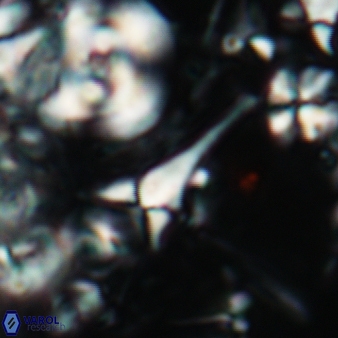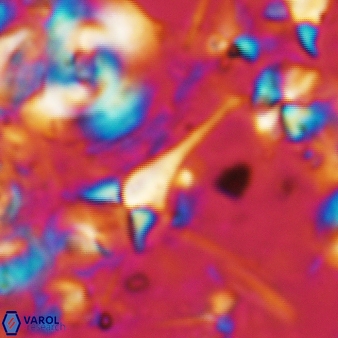Furcatolithus expansus
Set number: 848
-
1
-
2
-
3
-
4
10µm
Furcatolithus expansus Varol, in prep.
Species of Furcatolithus Martini,1965 bearing a duolithic biconical apical spine which is a kite shape in the axial section and a hollow conical frustum shape proximal cycle.
From Latin expansus, expand - referring to its expanding proximal cycle
Furcatolithus expansus has a duolithic biconical apical spine with or without bifurcation distally and a relatively high hollow conical frustum shape proximal cycle flaring outward. The apical spine is a kite shape in the axial section with an obtuse proximal angle.
In polarised light, the apical spine shows maximum birefringence at 45° but extinct (dim) at 0° [the axial suture between the two helves is better seen at this orientation].
Furcatolithus expansus differs from Furcatolithus distentus Martini,1965 by having a hollow conical frustum shape proximal cycle, whereas the latter has a cylindrical proximal cycle.
Sphenolithus expansus and Sphenolithus patifunditus (Bergen & de Kaenel in Bergen et al. 2017) Howe, 2021 have high hollow conical frustum shape proximal cycles (flaring outward). They differ by the proximal angle of their apical spines. Sphenolithus expansus has an obtuse proximal angle in the axial section, whereas Sphenolithus patifunditus has an acute proximal angle.
Bergen, J. A., de Kaenel, E., Blair, S. A., Boesiger, T. M. & Browning, E. 2017. Oligocene-Pliocene taxonomy and stratigraphy of the genus Sphenolithus in the circum North Atlantic Basin: Gulf of Mexico and ODP Leg 154. Journal of Nannoplankton Research 37(2-3): 77-112.
Bramlette, M. N. & Wilcoxon, J. A. 1967. Middle Tertiary calcareous nannoplankton of the Cipero section, Trinidad, W.I. Tulane Studies in Geology and Paleontology 5: 93-131.
Howe, R., 2021. Ultrastructure and taxonomy of the family Sphenolithaceae. Journal of Nannoplankton Research 39(1), 29-75.
Martini, E. 1965. Mid-Tertiary calcareous nannoplankton from Pacific deep-sea cores. Colston Papers 17: 393-411.

